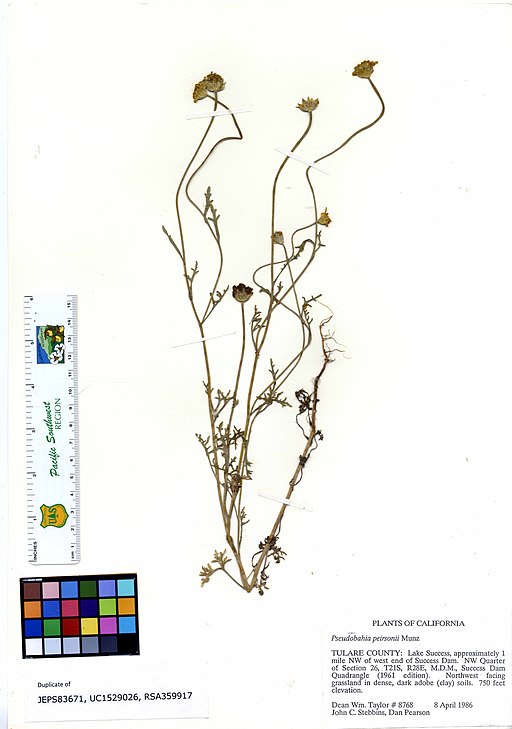Classification System: APG IV
Superregnum: Eukaryota
Regnum: Plantae
Cladus: Angiosperms
Cladus: Eudicots
Cladus: Core eudicots
Cladus: Asterids
Cladus: Campanulids
Ordo: Asterales
Familia: Asteraceae
Subfamilia: Asteroideae
Tribus: Madieae
Subtribus: Baeriinae
Genus: Pseudobahia
Species: Pseudobahia peirsonii
Name
Pseudobahia peirsonii Munz, 1949
Distribution
Native distribution areas:
Continental: Northern America
Regional: Southwestern USA
USA (California)
References: Brummitt, R.K. 2001. TDWG – World Geographical Scheme for Recording Plant Distributions, 2nd Edition
References
Philip Alexander Munz, Aliso. a series of papers on the native plants of California. [Title originally El Aliso] 2:84. 1949
Links
International Plant Names Index. 2018. Pseudobahia peirsonii. Published online. Accessed: Feb. 20 2018.
The Plant List 2013. Pseudobahia peirsonii in The Plant List Version 1.1. Published online. Accessed: 2018 Feb. 20.
Tropicos.org 2018. Pseudobahia peirsonii. Missouri Botanical Garden. Published online. Accessed: 20 Feb. 2018.
Hassler, M. 2018. Pseudobahia peirsonii. World Plants: Synonymic Checklists of the Vascular Plants of the World In: Roskovh, Y., Abucay, L., Orrell, T., Nicolson, D., Bailly, N., Kirk, P., Bourgoin, T., DeWalt, R.E., Decock, W., De Wever, A., Nieukerken, E. van, Zarucchi, J. & Penev, L., eds. 2018. Species 2000 & ITIS Catalogue of Life. Published online. Accessed: 2018 Feb. 20. Reference page.
USDA, ARS, Germplasm Resources Information Network. Pseudobahia peirsonii in the Germplasm Resources Information Network (GRIN), U.S. Department of Agriculture Agricultural Research Service. Accessed: 07-Oct-06.
Vernacular names
English: San Joaquin adobe sunburst
Pseudobahia peirsonii is a rare species of flowering plant in the family Asteraceae known by the common names San Joaquin adobe sunburst[2] and Tulare pseudobahia. It is endemic to California, where it is known from a few mostly small occurrences along the southeastern side of the San Joaquin Valley where it rises into the Sierra Nevada foothills. It grows in grassland and oak woodland habitat. It prefers heavy adobe clay soils.[1] The plant became a federally listed threatened of the United States in 1997.[1][3]
This species is an annual herb growing 20 to 70 centimeters tall. It has a thin coating of woolly hairs. The leaves are up to 6 centimeters long and are generally divided into a few leaflets which are subdivided into lobed segments. The inflorescence is a solitary flower head lined with about eight phyllaries which are fused at the base, making the involucre a rounded cup with pointed lobes. There are about 8 golden ray florets. At the center of the head are yellow disc florets.
The main threat to its remaining populations is destruction of its habitat for residential development.[1] Other threats include grazing and agriculture and maintenance of flood control structures, transmission lines, and roads.[1] The heavy presence of competitive exotic plants in the habitat, including charlock (Sinapis arvensis), stork's bill (Erodium cicutarium), and non-native bromes, is detrimental.[1]
References
USFWS. Determination of Endangered Status for Pseudobahia bahiifolia (Hartweg's golden sunburst) and Threatened Status for Pseudobahia peirsonii (San Joaquin adobe sunburst), Two Grassland Plants From the Central Valley of California. Federal Register February 6, 1997.
USDA, NRCS (n.d.). "Pseudobahia peirsonii". The PLANTS Database (plants.usda.gov). Greensboro, North Carolina: National Plant Data Team. Retrieved 15 October 2015.
California Native Plant Society Rare Plant Profile
Retrieved from "http://en.wikipedia.org/"
All text is available under the terms of the GNU Free Documentation License


